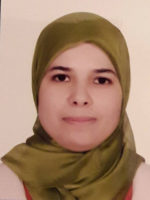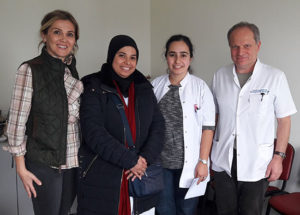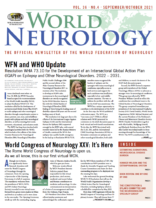By Dr. Imane Hajjaj

Imane Hajjaj
I was reading a regular newsletter from World Federation of Neurology, when I saw the announcement of “The Department Visit.” It stated that it was a one-month long visit, which suited me since it wasn’t possible for me to stay away from my country more than this period. Therefore, I decided to participate in and subsequently applied for the Turkey offer.
The choice included fourcities (Istanbul, Konya, Ankara, and Izmir). All of these cities were interesting, although I had a preference for Istanbul. My first objective for applying for this grant was to see how a neurology department looks like outside my country and see the difference concerning organization, systems, and logistics of the care of the neurological patient. Second, I was interested in having an idea about the most frequent diseases and their treatments. I had the answer, and it was a positive one. I booked my flight, and I went to Istanbul. Yes. It was the city I chose. My visit occurred from Dec. 10, 2019, to Jan. 8, 2020.
My accommodations were a 3-minute walk from my hotel to the “Cerrahpaşa Tıp Fakültesi” hospital. On the first day, I met the head of the neurology department, Prof. Sabahattin Saip, who welcomed me and told me that the hospital experienced some damage from a new earthquake, and they were obliged to build a temporary neurology department. Hence, it was a transition period. Then, I met the smiling and nice Prof. Derya Uluduz. With her, I saw for the first time a Doppler embolic shower. On the same first day, I met Prof. Melih Tütüncü and Prof. Aksel Silva. I assisted them at outpatient (poliklinik). It was a rich set of outpatient cases: CADASIL, MS, neurosarcoidosis, Fabry, Behcet, Lyme, spastic paraparésie, among others.
Neurology consultations (polikilinik noroloji) are specialized. There are rooms devoted to MS, dementia, abnormal movements, neuropediatrics, stroke, peripheral nerves, and others. The consultation rooms have computers with intranet and internet, and the neurologists often use them to fill in the patients’ files, do research and see the MRI images.
I spent most of the time of my traineeship between neuropediatric outpatient and EEGs of children. During the child video-EEG lecture, discussions were rewarding and fruitful between neurology residents. Prof. Ahmet Veysi, Demirbilek and us saw many types of seizures (interesting and rich bank of seizure types). Many times before giving the EEG report to a patient, we met the patient’s parents, and we obtained more information about his/her history and evolution under treatment. I noticed that there were many patients under treatment for years even if they were free of seizures. Moreover, Prof. Veysi loved to keep contact with his patients even when they grew up and were more than 16 years old and had to go to adult outpatient. In neuropediatric consultation, more cases were of epilepsy and genetic disorders.

Photo taken on my last day in the neurology department (Istanbul). From left to right: Prof. Derya Uluduz (neurologist), Dr. Imane Hajjaj (author, neurologist), Dr. Zeynep Ece Kaya (resident in neurology), and Prof. Sabahattin Saip (head of neurology department).
Other interesting outpatients included multiple sclerosis and other white matter disorders (with Prof. Silva and Prof. Melih). Many cases required reflection and discussion between these two teachers and sometimes the consultations ended around 7 p.m. The choice of MS medications is wide, the switch is often easy, and the MRIs are easy to perform on a regular basis. What I appreciated was the use of the CDs to see the images of the MRI (or on their smartphones). It was exceptional to see a patient bringing pictures with them, and on the other hand, we found with them their files containing their blood tests and medical reports.
I also attended the performance of EMGs with residents and attached neurologists. I appreciated the fact that they give sheets where we explain to patients what an EMG is and how to prepare it.
What drew my attention most was that the patients who brought self-adhesive labels containing their insurance code and their names, and doctors put this label on prescriptions and vouchers for checkups and imagery.
I had the opportunity to visit the neurology department side of the hospital, which was relocated because of the earthquake to the radiology and neurosurgery building. There was one patient per room and was accompanied by a family member. The room was adequately equipped with everything related to a neurological patient.
One of the things that I liked and appreciated was the daily midday meeting. It is a moment of meeting of all the neurological medical team (professors, attached neurologists, residents in neurology) that takes place from 12:30 p.m. to 1:30 p.m., and it is a time to have lunch as well. (It is often offered by the service but the doctors can bring their own lunches with them.) The team meets again to make a presentation, or discuss a clinical case or MRI image. Sometimes the team brings back a patient who describes his/her illness, and the doctors ask him/her questions, try to discuss the case, make the right diagnosis, and offer the adequate therapy.
There is a beautiful atmosphere between residents, teachers, and paramedics. The entire department of neurology celebrated the New Year 2020 with a rich and varied buffet and a large cake. Another day, residents prepared a surprise for their teacher on the occasion of his birthday. Patients offer their doctors gifts to show their recognition and satisfaction. I thought I would have a language problem, but I met professors and residents who speak English or even French and who found it easy to translate and explain the cases of the patients to me.
My last day with the neurology team was focused on an article in English, and the discussion was rich and addressed the social and human side of medical practice.
My stay in Istanbul was an enriching experience for me, and I find that a month is a short period, but it is quite enough to have an idea about the functioning of a neurology service. Many thanks go to all Turkish neurologists I met. Thank you to the Turkish Society of Neurology and to the World Federation of Neurology, and a special thought to Burak Tokdemir and Miray Atacan. •
Dr. Imane Hajjaj is a neurologist in Agadir City, Morocco.
